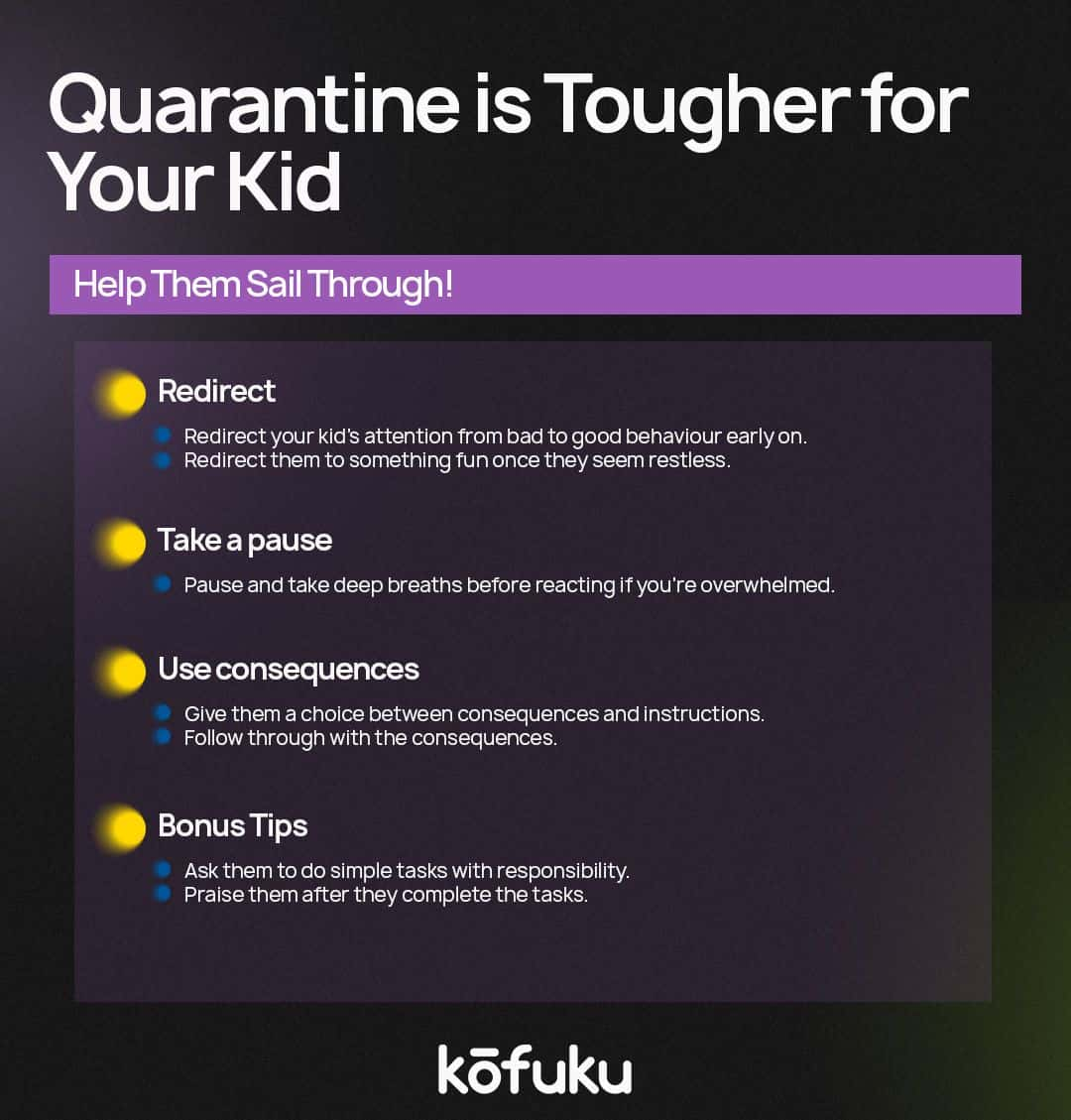Navigating Quarantine with Kids: A Parent's Survival Guide

Introduction
Words like ‘quarantine’ and ‘isolation’ were introduced into our daily vocabulary in 2020 for everyone worldwide. Although they are very different words, they are generally used interchangeably, and with the new HMPV virus, people are starting to use them more. For parents, these words are very important as they not only have to keep themselves safe but their kids too.
So we’re here to help give some quarantine and isolation guidelines for families while ensuring the safety, health, and well-being of their little ones.
What’s the Difference Between Quarantine and Isolation?
As we said, the terms are often used interchangeably, but quarantine and isolation are very different, and they serve distinct purposes:
-
Quarantine is for people who may have been exposed to a contagious disease but are not showing symptoms. It’s a preventive measure to limit potential spread.
-
Isolation is for people who are confirmed to have the disease. It involves separating them from others to prevent transmission.
For families, understanding these differences is vital for implementing the right protocols.
Best Practices For Quarantining With Family Members
When one family member needs to quarantine, remember that it’s important to minimise contact with everyone in the household because of how close everyone is together. Here’s how to do it effectively:
1. Designate a Quarantine Area:
Choose a separate room for the quarantined person, preferably one with an attached bathroom and, if they're an adult, maybe an attached balcony, too. If that’s impossible, clean and disinfect shared bathrooms after every use.
2. Use Separate Household Items:
Ensure that the quarantined person uses their own dishes, towels, and bedding and does not share personal items.
3. Limit Interactions:
Keep interactions to a minimum, maintaining a distance of at least six feet. Everyone should wear masks during any necessary contact, and no, playing Uno with the fam is not necessary.
4. Ventilation Matters:
Keep windows open and use fans to improve air circulation in shared spaces.
5. Hygiene Is Key:
Make sure everyone washes and sanitises their hands often.
Isolation Practices for Families
If someone in the family tests positive for a contagious illness, isolation is a must-do. Here are some tips to manage this:
1. Complete Separation:
Ideally, the infected person should stay in a separate room and avoid all physical contact with everyone else in the house, especially those at high risk, like the little ones and grandparents.
2. Personal Protective Equipment:
Caregivers or nurses who help out should wear masks and gloves when treating the isolated person, and they should wash their hands thoroughly afterwards.
3. Monitor Symptoms:
Keep a close eye on the health of the isolated person and other family members. Have a thermometer and pulse oximeter on hand for regular checks..
4. Coordinate Medical Care:
Stay in touch with the healthcare provider for any other suggestions and monitor the infected person (from a distance) for any signs of worsening symptoms.
Managing Family Life During Quarantine
Balancing household responsibilities, your office life (assuming you’re working from home), and managing the family during this time can feel quite overwhelming, but don’t worry! We’re here to give you some practical tips:
1. Create a Routine:
Maintain a daily schedule for meals, activities, and rest to provide structure and stability.
2. Divide Responsibilities:
Assign chores and caregiving duties among family members to reduce the burden on one person.
3. Stay Connected Virtually:
Use video calls, Instagram, and WhatsApp to keep in touch with the quarantined or isolated family member so they’re not missing out on the fun on the outside.

Household Isolation Protocols
And to minimise the spread of illness within a household, follow these protocols:
- Clean Frequently:
Disinfect high-touch surfaces like doorknobs, light switches, and remote controls daily.
- Laundry Care:
Wash the isolated person’s clothes and bedding separately using hot water and detergent.
- Trash Disposal:
Use a lined trash can and make sure the bag is sealed properly before disposing of it.
Keeping The Family Safe During Quarantine
While protecting everyone’s physical health is crucial, don’t overlook emotional well-being so here are ways to support your family:
1. Be Open With Everyone:
Let everyone, including kids, express their fears or frustrations and validate their feelings. They’d hate being cooped up at home, so remember to be there for them.
2. Focus on Positivity:
Celebrate small milestones, like completing a week of quarantine or getting all of the housework done.
3. Practice Mindfulness:
Take part in activities like meditation, yoga, or journaling to reduce stress.
Supporting Children During Quarantine and Isolation
With the sudden change in routine, the children will miss their apartment friends and might struggle. So here are some tips to support them:
- Interactive Activities:
Play board games, cards, or puzzles with them so they don’t get bored.
- Quality Time:
Dedicate time for family games or movie night to while away time together.
- Study Time:
It's a bit idealistic, but it’s the perfect time for them to get their grades back up!
Family Quarantine Checklist
Preparation can make or break a quarantine, so here’s a checklist for you to tick off:
-
Thermometer and medical supplies.
-
Masks, gloves, and hand sanitisers.
-
Cleaning and disinfecting supplies.
-
Separate household items for the quarantined person.
-
Non-perishable foods and meal plans.
-
Entertainment things like books, board games, and don’t forget about your Netflix and Spotify subscriptions.

Mental Health Tips for Families in Quarantine
Quarantine can be a lot. It will take a toll on mental health. Here are some ways you can get by:
-
Stay Active: Add exercise to your daily routine; even if it’s just a 10-minute stretch or some yoga moves, just do it!
-
Limit News Consumption: Stop watching the news all day, as that can make you more anxious.
-
Seek Professional Help: Don’t hesitate to consult a counsellor or therapist if everything becomes overwhelming. You can now book therapy sessions online!
Caring for Family Members in Isolation
You’ll need to plan when you’re taking care of your family member who is in isolation:
-
Meal Delivery: Place meals outside their door to minimise contact.
-
Health Monitoring: Track their symptoms and give them medications like Dolo if they need some relief from the symptoms, but consult your doctor first.
-
Emotional Support: WhatsApp chats, Zoom calls, and Discord games can make the quarantine time quite fun!
Setting Up Your Home for Quarantine and Isolation
Prepare your home to handle quarantine and isolation smoothly:
-
Designate a specific area for the quarantined or isolated person, and nobody else is allowed there.
-
Stock up on essentials, but with quick commerce, you can always get groceries delivered!
-
Create a cleaning schedule for shared spaces.
Quarantine Meal Planning for Families
A well-thought-out meal plan can reduce stress:
-
Batch Cooking: Prepare and freeze meals in advance.
-
Simple Recipes: Focus on dishes that require minimal ingredients and effort.
-
Healthy Choices: Include fruits, vegetables, and immunity-boosting foods in your meals.
Adjusting to Life After Quarantine
Once the time in the dungeon is finally over, you can slowly transition back to your usual life!
-
Gradual Reintegration: Allow time for everyone to get back to their regular routines slowly.
-
Health Monitoring: Ensure you’re still looking for symptoms and consult a doctor.
-
Celebrate Resilience: Thank everyone in your family for overcoming the challenge, and go out to celebrate together!
Conclusion
Now, we hope you’ve understood the difference between quarantine and isolation and what to do when you’re locked up at home with your family! We’re not going to lie; it will be difficult. But after reading this blog, we hope it will be easier!


Expressing Mental Health Vulnerability – Why It's Important

Modern Media’s Effect on Mental Health: Key Concerns

Debunking Exercise Myths – What’s Effective and What’s Not


